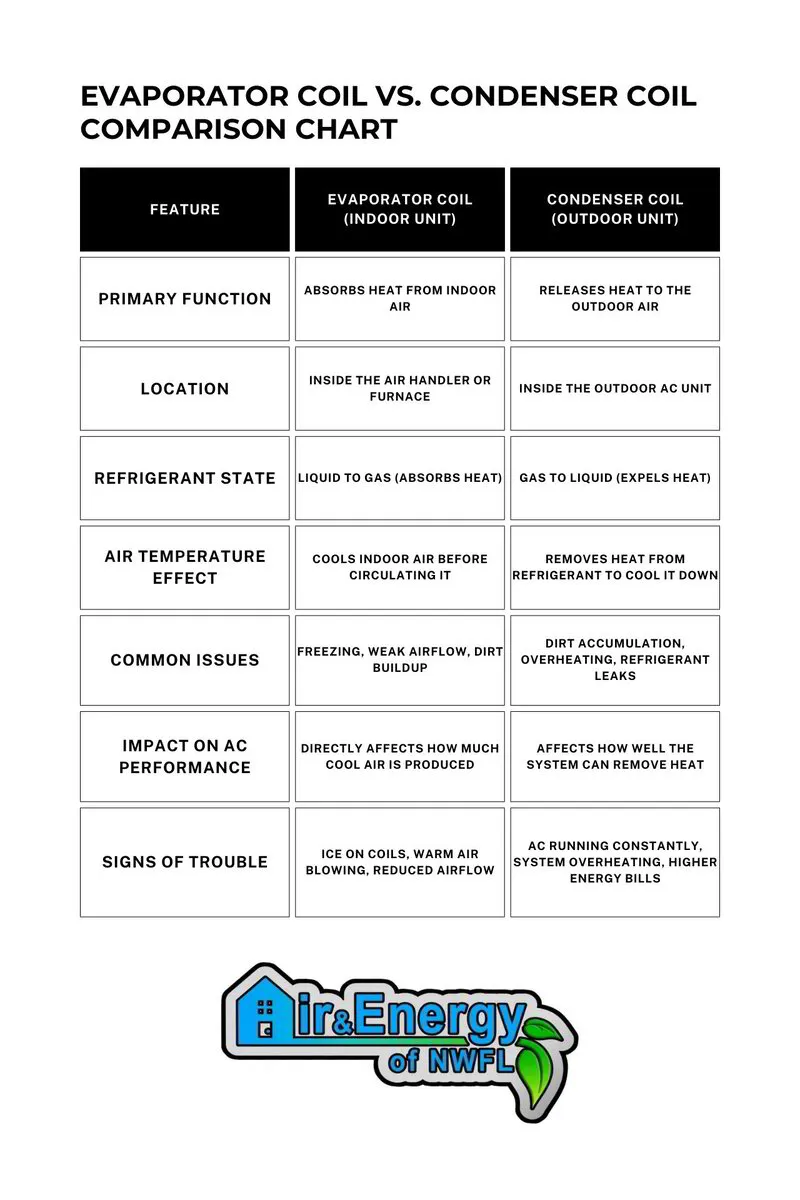If your central AC or mini-split system is running but not cooling properly, the issue may be with the evaporator or condenser coil—two key components that regulate temperature.
The evaporator coil absorbs heat from indoor air, while the condenser coil releases it outside. When either gets dirty, blocked, or damaged, your AC loses efficiency, struggles to cool, and increases energy costs.
This guide covers the difference between evaporator and condenser coils, how they work in both system types, common issues, and essential maintenance tips to keep your AC running smoothly
Evaporator Coil: What It Is and How It Works

Think of your evaporator coil like a sponge soaking up heat. In central air conditioning systems, it’s located inside the air handler or furnace, while in mini-split systems, it’s inside each indoor wall-mounted unit.
The evaporator coil is made of copper tubing with aluminum fins, which help absorb heat effectively from the surrounding air. The refrigerant inside the copper tubes absorbs heat energy as air passes over the fins, facilitating the heat transfer process.
Here’s how the heat transfer process works in your air conditioning system:
- Warm indoor air flows over the evaporator coil, where the refrigerant inside absorbs heat energy, causing it to evaporate from a liquid to a gas.
- The now-cooled air is circulated back into your home, while the heat is carried away through the refrigerant.
- The expansion valve controls how much refrigerant enters the coil, ensuring efficient cooling.
- The refrigerant, now a low-pressure gas, moves through the heat transfer process to the condenser coil outside.
A properly functioning evaporator coil ensures your air conditioner runs efficiently by absorbing heat energy from your home. Next, let’s look at how the condenser coil releases that heat outdoors.
Condenser Coil: What It Is and How It Works

If the evaporator coil is like a sponge soaking up heat, the condenser coil is like a car radiator—expelling that heat to keep your air conditioner running efficiently.
The condenser coil is located in the outdoor unit in both central AC and mini-split systems. It is made of copper coils with aluminum fins, which allow it to release heat energy into the outside air more efficiently.
Here’s how the heat transfer process works:
- After the evaporator coil absorbs heat, the refrigerant carries the heat energy to the outdoor condenser coil as a high-pressure gas.
- The condenser fan blows outdoor air over the aluminum fins, helping the refrigerant release heat energy more effectively.
- As the refrigerant cools, it condenses back into a high-pressure liquid, completing the heat transfer process.
- The expansion valve then regulates refrigerant flow, ensuring the air conditioning system continues absorbing and releasing heat efficiently.
A properly functioning condenser coil ensures that your system removes heat efficiently, maintaining optimal energy efficiency. Heat transfer is restricted if it becomes blocked or dirty, making your air conditioner work harder.
Now that we understand how both coils function, let’s compare their differences and how they impact your AC system’s performance.
Evaporator Coil vs. Condenser Coil: Side-by-Side Comparison
Your evaporator coil and condenser coil work together but have opposite roles in the cooling process. The evaporator coil absorbs heat, while the condenser coil releases heat outdoors. If either coil is dirty, damaged, or blocked, your AC won’t cool effectively.
Here’s a quick comparison:
Now that we know how they function, let’s go over essential maintenance tips to keep both coils in top shape.
Maintenance Tips for Both Coils
Keeping your evaporator and condenser coils clean is one of the best ways to prevent breakdowns, reduce energy costs, and maintain strong cooling performance. Here’s how:
Evaporator Coil Maintenance (Indoor Unit - Central & Mini-Split Systems)
✅ Clean or Replace Your Air Filter Regularly – Mini-split filters are washable and should be cleaned every 2-4 weeks. Central AC filters should be replaced every 1-3 months.
✅ Inspect for Dust and Dirt – Use a soft brush or compressed air to remove debris.
✅ Use an Approved Evaporator Coil Cleaner – A no-rinse foaming cleaner helps break down grime and mold buildup.
✅ Check for Proper Airflow – Keep vents and indoor units clear to prevent circulation problems.
🚫 Avoid spraying water directly onto the coil, as it can damage electrical components.
Condenser Coil Maintenance (Outdoor Unit - Central & Mini-Split Systems)
✅ Clear Away Leaves and Debris – Mini-split outdoor units are smaller, so even minor obstructions impact efficiency.
✅ Wash the Coil Gently – Use a low-pressure garden hose to rinse dirt from the fins.
✅ Use a Coil Cleaner – Apply a condenser coil cleaner, let it sit, then rinse.
✅ Straighten Bent Fins – Use a fin comb to fix bent fins for better airflow.
🚫 Never use high-pressure water, as it can damage the delicate fins.
🧑🔧 Pro Tip: Schedule a professional mini-split or central AC tune-up once a year to check for refrigerant leaks, electrical issues, and deep coil cleaning.
Troubleshooting Common AC Coil Problems
Even with proper maintenance, coils can develop issues. Here’s how to spot and fix the most common problems before calling a pro.
Evaporator Coil Freezing Up ❄️
🔍 Signs: Ice buildup, weak airflow, AC blowing warm air.
✅ Try This First:
- Check and clean or replace the air filter to improve airflow.
- Open vents and remove any obstructions blocking air circulation.
- Turn the AC off for a few hours to let the ice melt.
🚫 If the issue persists, you may have a refrigerant leak—call a technician.
Condenser Coil Overheating 🔥
🔍 Signs: AC runs constantly, feels extremely hot, high energy bills.
✅ Try This First:
- Remove leaves and debris around the outdoor unit.
- Gently hose down the outdoor condenser unit to remove dirt buildup.
- Check if the condenser fan is running—if not, it may need repair.
🚫 If your AC keeps shutting down, schedule a professional inspection.
When to Replace Your Evaporator or Condenser Coil
Most evaporator and condenser coils last 10–15 years, but persistent refrigerant leaks, corrosion, or frequent repairs may require replacement.
If your system is more than 10 years old, replacing both coils together prevents efficiency loss and avoids mismatched components. Additionally, if your AC uses an older refrigerant like R-22 or even R-410A, you’ll need to upgrade to a system that supports R-32 or other next-generation refrigerants. In that case, both coils must be replaced anyway to ensure full compatibility with the new refrigerant.
🧑🔧 Expert Tip: If repair costs exceed 50% of the price of a new system, investing in a replacement is often the smarter choice for energy savings, long-term reliability, and compliance with modern refrigerants.
Conclusion
Understanding the evaporator coil vs. condenser coil helps keep your central AC or mini-split running efficiently. Routine filter cleaning, coil maintenance, and airflow checks prevent common issues.
Pensacola homeowners, if your AC isn’t cooling properly, contact Air & Energy of NWFL for a professional mini-split or central AC tune-up. Call today to keep your home cool and comfortable year-round!

This article was written by:
Co-founder and Home Comfort Specialist


